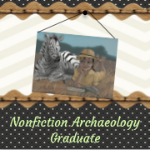
Published by: Eerdmans Books for Young Readers 2015
Publisher's Summary: Abraham Dee Bartlett knew from a young age that he wanted to spend his life working with animals. But in Victorian London, there weren’t many jobs that provided an opportunity to do that. Still, Abraham spent years gaining knowledge and pursuing his dream until he eventually became superintendent in the London Zoo. Driven by his compassion for the animals, Abraham dramatically improved the conditions of the zoo to ensure that the animals could be happy and healthy.
With engaging back matter and charming illustrations, Cassandre Maxwell’s book brings to life the little-known story of the man who helped to create the modern zoo.
Like many of you, I have been enthralled by the editor of Eerdmans nonfiction posts on their website. Naturally it enticed me to grab one of their books and see how it stacked up to my trusty compass test that never lets me down in finding my direction.
Nugget: Abraham Dee Bartlett and the Invention of the Modern Zoo. -- Nice nugget, children love animals. Needless to say, I was curious.
Need Enticement: From the time he was a little boy, Abraham Dee Bartlett loved animals. He was fascinated by anything with fur, fins or feathers. --not very exciting, I can't say that I was hooked.
Escalation: His father knew a man that owned animals, people lined up for animals (this set up is three pages) before we get to... the man let Abraham play with the animals. He reads about them, grows up to work with animals then gets a job with the London Zoo.
He is a very hands-on zookeeper. He makes many changes still in effect today such as zoo guides and description plates by each animal. He works to help find ways to help injured and dying animals.
In the end, the Queen is impressed with him, but the animals aren't. They howl and grunt at night. He comes up with the idea of large habitats that emulate their natural homes much like we see today.
Satisfying Ending: And, proud as any papa, he welcomed thousands of visitors to marvel at the magnificent animals, happy at last in their home at the zoo. --Does this ending fulfill the story promise that is set in the beginning? No. Who is the papa? This was the entire last section as though it was a paragraph. Did his love do this? Were all the fur, fin, and feathers at home in the zoo? This ending left me wanting more.
Sources: Great timeline, author's note, small bibliography, but there are tips for further reading.
Show Words: This area disappointed me, they could have had a nice vocabulary in the back of the book. The only word I thought would engage talk was "sedate." The end of this book was all about the animals talking, but never once did they mention the actual language of an animal. They mention Abraham listening to a lullaby of grunts, hoots, etc. Then show a picture of a giraffe- giraffes DON'T make a sound.
Why: This book will entice children. It is fascinating to think how far we have come from small boxes where lions traveled from one town to the next. To what we have now, make shift prides, where we can watch lions in a somewhat natural atmosphere. Fascinating.
Need and Want: Abraham wanted a life devoted to animals, he wanted to help them, play with them, fix them. But, deep down he realized that the animals weren't happy. Who wants to be confined? Making the best of a bad situation, he came up with the idea of large habitats where the animals were surrounded by their natural plants and surroundings.
** Overall I do like this book but it leads you off the beaten path and now and then we find our way back to the bread crumb trail. The story is fascinating, and I look forward to researching it even more.
Publisher's Summary: Abraham Dee Bartlett knew from a young age that he wanted to spend his life working with animals. But in Victorian London, there weren’t many jobs that provided an opportunity to do that. Still, Abraham spent years gaining knowledge and pursuing his dream until he eventually became superintendent in the London Zoo. Driven by his compassion for the animals, Abraham dramatically improved the conditions of the zoo to ensure that the animals could be happy and healthy.
With engaging back matter and charming illustrations, Cassandre Maxwell’s book brings to life the little-known story of the man who helped to create the modern zoo.
Like many of you, I have been enthralled by the editor of Eerdmans nonfiction posts on their website. Naturally it enticed me to grab one of their books and see how it stacked up to my trusty compass test that never lets me down in finding my direction.
Nugget: Abraham Dee Bartlett and the Invention of the Modern Zoo. -- Nice nugget, children love animals. Needless to say, I was curious.
Need Enticement: From the time he was a little boy, Abraham Dee Bartlett loved animals. He was fascinated by anything with fur, fins or feathers. --not very exciting, I can't say that I was hooked.
Escalation: His father knew a man that owned animals, people lined up for animals (this set up is three pages) before we get to... the man let Abraham play with the animals. He reads about them, grows up to work with animals then gets a job with the London Zoo.
He is a very hands-on zookeeper. He makes many changes still in effect today such as zoo guides and description plates by each animal. He works to help find ways to help injured and dying animals.
In the end, the Queen is impressed with him, but the animals aren't. They howl and grunt at night. He comes up with the idea of large habitats that emulate their natural homes much like we see today.
Satisfying Ending: And, proud as any papa, he welcomed thousands of visitors to marvel at the magnificent animals, happy at last in their home at the zoo. --Does this ending fulfill the story promise that is set in the beginning? No. Who is the papa? This was the entire last section as though it was a paragraph. Did his love do this? Were all the fur, fin, and feathers at home in the zoo? This ending left me wanting more.
Sources: Great timeline, author's note, small bibliography, but there are tips for further reading.
Show Words: This area disappointed me, they could have had a nice vocabulary in the back of the book. The only word I thought would engage talk was "sedate." The end of this book was all about the animals talking, but never once did they mention the actual language of an animal. They mention Abraham listening to a lullaby of grunts, hoots, etc. Then show a picture of a giraffe- giraffes DON'T make a sound.
Why: This book will entice children. It is fascinating to think how far we have come from small boxes where lions traveled from one town to the next. To what we have now, make shift prides, where we can watch lions in a somewhat natural atmosphere. Fascinating.
Need and Want: Abraham wanted a life devoted to animals, he wanted to help them, play with them, fix them. But, deep down he realized that the animals weren't happy. Who wants to be confined? Making the best of a bad situation, he came up with the idea of large habitats where the animals were surrounded by their natural plants and surroundings.
** Overall I do like this book but it leads you off the beaten path and now and then we find our way back to the bread crumb trail. The story is fascinating, and I look forward to researching it even more.
 RSS Feed
RSS Feed




